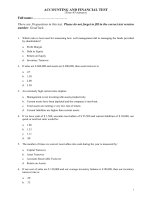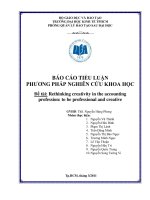Responsibility accounting
Bạn đang xem bản rút gọn của tài liệu. Xem và tải ngay bản đầy đủ của tài liệu tại đây (1.01 MB, 40 trang )
COST MANAGEMENT
Accounting & Control
Hansen▪Mowen▪Guan
Chapter 10
Decentralization:
Responsibility Accounting,
Performance Evaluation, and Transfer Pricing
COPYRIGHT © 2009 South-Western Publishing, a division of Cengage Learning.
Cengage Learning and South-Western are trademarks used herein under license.
1
Study Objectives
1. Define responsibility accounting, and describe the four
types of responsibility centers.
2. Explain why firms choose to decentralize.
3. Compute and explain return on investment (ROI),
residual income (RI), and economic value added (EVA).
4. Discuss methods of evaluating and rewarding
managerial performance.
5. Explain the role of transfer pricing in a decentralized
firm.
6. Discuss the methods of setting transfer prices.
2
Responsibility Accounting
Responsibility accounting
– measures the results of each responsibility center
– compares those results with some measure of
expected or budgeted outcome.
3
Responsibility Accounting
Types of Responsibility Centers
–
–
–
–
Cost center: only responsible for costs
Revenue center: only responsible for revenues
Profit center: responsible for both revenues and costs
Investment center: responsible for revenues, costs,
and investments
4
Decentralization
Reasons for Decentralization
–
–
–
–
–
–
Better access to local information
More timely response
Focusing of central management
Training and evaluation of segment managers
Motivation of segment managers
Enhanced competition
5
Measuring the Performance of
Investment Centers
Return on investment (ROI)
the most common measure of performance for
an investment center
ROI = Operating income ÷ Average operating assets
= (Operating income ÷ Sales) × (Sales ÷ Average operating assets)
= Operating income margin × Operating asset turnover
Margin: portion of sales
available for interest, taxes
and profit
Operating income
÷
Sales
Turnover: how productively
assets are being used to
generate sales
Sales
÷
Average operating assets
6
Measuring the Performance of
Investment Centers
7
Measuring the Performance of
Investment Centers
8
Measuring the Performance of
Investment Centers
Advantages of the ROI measure
– Helps managers focus on the relationship between
sales, expenses and investment.
– Encourages cost efficiency.
– Discourages excessive investment in operating assets
Disadvantages of the ROI measure
– Discourages managers from investing in projects
decreasing divisional ROI but increasing profitability of
the company overall.
– Encourages managers to focus on the short-term at
the expense of the long-term.
9
Measuring the Performance of
Investment Centers
Residual income
the difference between operating income and the
minimum dollar return required on a company’s
operating assets
(
Residual = Operating - Minimum rate of return
Income
Income
× Operating assets
)
10
Measuring the Performance of
Investment Centers
Advantages of Residual Income
Project I
Residual income = $1,300,000 - (0.10 × $10,000,000)
= $1,300,000 - $1,000,000
= $300,000
Project II
Residual income = $640,000 - (0.10 × $4,000,000)
= $640,000 $400,000
= $240,000
11
Measuring the Performance of
Investment Centers
Disadvantages of Residual Income
ROI is an absolute measure of return; it
does not discourage myopic behavior
Division A
Division B
Average operating assets
$15,000,000
$2,500,000
Operating income
$ 1,500,000
$ 300,000
1,200,000
200,000
300,000
$ 100,000
Minimum returna
Residual income
Residual returnb
$
2%
4%
0.08 × Operating assets.
a
Residual income divided by operating assets.
b
12
Measuring the Performance of
Investment Centers
Economic value added (EVA)
after-tax operating profit minus the total annual cost of capital.
(
After-tax
EVA = operating - Weighted average cost of capital
× Total capital employed
income
)
Total capital employed = capital assets
plus other expenditures meant to have
a long-term payoff
13
Measuring the Performance of
Investment Centers
EVA Example
14
Measuring the Performance of
Investment Centers
EVA Example (continued)
Furman’s EVA is:
After-tax profit
$1,583,000
Less: Weighted average cost of capital
(1,470,000)
EVA
$ 113,000
The positive EVA means that Furman, Inc., earned operating
profit over and above the cost of the capital used.
15
Measuring the Performance of
Investment Centers
Behavioral Aspects of EVA
Hardware
Division
Sales
Cost of goods sold
Gross profit
Divisional selling and
administrative expenses
Operating income
Average cost of capital = 11%
Capital used
Cost of capital
Software
Division
$5,000,000
2,000,000
$3,000,000
$2,000,000
1,100,000
$ 900,000
2,000,000
$1,000,000
400,000
$ 500,000
$10,000,000
$1,100,000
$2,000,000
$220,000
16
Measuring the Performance of
Investment Centers
Behavioral Aspects of EVA
Tends to focus on long-run
Hardware
Discourages myopic behavior Division
Operating income
Less: Cost of capital
EVA
Software
Division
$1,000,000
$500,000
1,100,000
220,000
$ (100,000)
$280,000
Positive EVA = wealth is being created
Negative EVA = capital is being destroyed
17
Measuring and Rewarding the
Performance of Mangers
• Measuring performance in the MNC
– Evaluate the division
– Evaluate the manger
• Base on factors where control exists
• Do not evaluate on factors over which there is no
control (currency fluctuations, income taxes, etc.)
18
Measuring and Rewarding the
Performance of Mangers
• MNC divisional ROIs impacted by
– International vs domestic environmental conditions
(economic, legal, political, social, etc.)
• Multiple measures of performance for
MNC divisions
– Consider market potential and market share
– Residual income and ROI should not be the sole
measures for MNC divisions
19
Measuring and Rewarding the
Performance of Mangers
• Managerial rewards
– Separation of ownership and management creates
the possibility that managers may not operate the
business in the best interest of the shareholders
• Managers do not exert the most productive effort
for the company
• Managers may spend company resources on
perquisites
– A well-structured incentive compensation system
encourages goal congruence
20
Measuring and Rewarding the
Performance of Mangers
• Cash compensation
– Reward good management performance by granting
periodic raises
• Become a permanent part of the compensation package
– Bonuses provide more flexibility
• Income-based compensation may encourage dysfunctional
behavior.
– A combination of salary and bonus keeps salaries
fairly level and allows bonuses to fluctuate with
reported income.
21
Measuring and Rewarding the
Performance of Mangers
• Stock-based compensation
– A stock option is the right to buy a certain number of
shares of the company’s stock, at a particular price
and after a set length of time.
– Stock options are offered to managers
• They become owners (shareholders) of the company
• Ownership encourages goal congruence
– The price of the stock is usually set to approximate
market price at the time of issue.
• If the stock price rises in the future, the manager may
exercise the option.
22
Measuring and Rewarding the
Performance of Mangers
• Issues to consider
– Single-measure outcomes encourage gaming
behavior
– The Big Bath
– Cash bonuses and stock options encourage shortterm orientation by management
• Noncash compensation
– Autonomy
– Perquisites
23
Transfer Pricing
Transfer prices are the prices charged for
goods produced by one division and
transferred to another.
The price charged affects the revenues of
the transferring division and the costs of the
receiving division.
24
Transfer Pricing
• A transfer pricing system should satisfy
three objectives:
– Accurate performance evaluation
– Goal congruence
– Preservation on divisional autonomy
25









